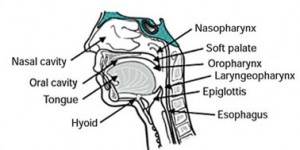Michael Douglas Diagnosed with throat cancer

Oscar winning actor/producer Michael Douglas, 65, announced yesterday that he has been diagnosed with a tumor in his throat. The “Wall Street” actor, son of Hollywood legend Kirk Douglas, and husband of Academy Award winner Catherine Zeta-Jones, will undergo 8 weeks of radiation and chemotherapy. According to People magazine ” his doctors expect the Wall Street star to make a full recovery.” Douglas told People “I am very optimistic.”
What is Throat Cancer?
Throat cancer is a cancer that forms in tissues of the pharynx (the tube inside the neck that starting behind the nose and ending at the top of the windpipe and esophagus). Throat cancer includes cancer of the nasopharynx (the upper part of the throat behind the nose), the oropharynx (the middle part of the pharynx), and the hypopharynx (the bottom part of the pharynx). Cancer of the larynx (voice box) may also be included as a type of throat cancer. Head and neck cancers account for approximately 3 to 5 percent of all cancers in the United States. These cancers are more common in men and in people over age 50. People who smoke or otherwise use tobacco are at risk of developing throat cancer. Excessive alcohol use also increases risk. Smoking and drinking alcohol combined lead to an increased risk for throat cancers.
A Review of the Anatomy of the Throat
- Pharynx. The pharynx is a hollow tube about 5 inches long that starts behind the nose and leads to the esophagus (the tube that goes to the stomach) and the trachea (the tube that goes to the lungs). The pharynx has three parts:
1. Nasopharynx: The nasopharynx, the upper part of the pharynx, is behind the nose.
2. Oropharynx: The oropharynx is the middle part of the pharynx. The oropharynx includes the soft palate (the back of the mouth), the base of the tongue, and the tonsils.
3. Hypopharynx: The hypopharynx is the lower part of the pharynx.
- Larynx. The larynx, also called the voicebox, is a short passageway formed by cartilage just below the pharynx in the neck. The larynx contains the vocal cords. It also has a small piece of tissue, called the epiglottis, which moves to cover the larynx to prevent food from entering the air passages.
Most head and neck cancers begin in the cells that line the mucosal surfaces in the head and neck area. Mucosal surfaces are moist tissues lining hollow organs and cavities of the body open to the environment. Normal mucosal cells look like scales (squamous) under the microscope, so head and neck cancers are often referred to as squamous cell carcinomas.
Symptoms of throat cancer include:
- Abnormal (high-pitched) breathing sounds
- Cough
- Coughing up blood
- Difficulty swallowing
- Hoarseness that does not get better in 1 - 2 weeks
- Neck pain
- Sore throat that does not get better in 1 - 2 weeks, even with antibiotics
- Swelling or lumps in the neck
- Unintentional weight loss
Of course, many of these symptoms can be seen with other illnesses, so seeing a physician is necessary to make a correct diagnosis.
For more information about throat cancers, click here to go to the Resounding Health casebook on Throat Cancer.

























0 comments